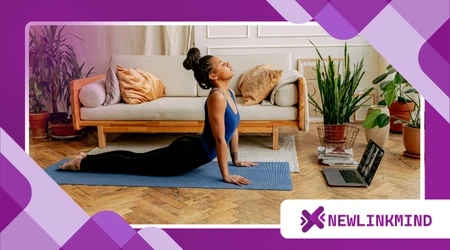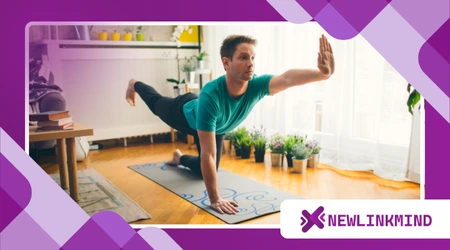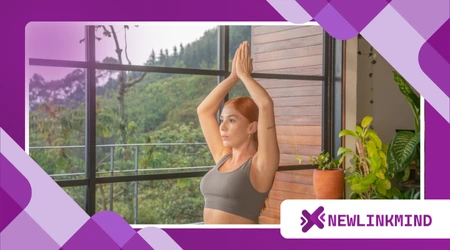How to Build a Weekly Yoga Routine at Home

Weekly Yoga Routine at Home Setting up a dedicated space is paramount. It doesn’t require an entire room; a quiet corner suffices.
Anúncios
Ensure it’s free from distractions, a place where calm can genuinely settle.Consider elements that foster serenity. Soft lighting, perhaps a candle, can transform the atmosphere.
A small plant or a meaningful object adds a personal touch, grounding your practice.Your mat is your island of tranquility. Choose one that offers good grip and comfort.
This simple investment greatly enhances your experience, preventing slips and discomfort.
Sound can elevate or disrupt. Experiment with gentle instrumental music or the soothing silence of your own breath. Some prefer ambient nature sounds, fostering a connection to the outdoors.
Anúncios
Keep props within reach. Blocks, straps, and blankets aren’t just for studios. They support your alignment and deepen stretches, making postures more accessible and safe.
Think about the air quality. A well-ventilated space prevents stuffiness. Even opening a window for a few minutes before practice can make a significant difference.
Consistency starts with convenience. If your space is inviting and ready, you’re far more likely to roll out your mat. Remove any hurdles that might deter you.
Anúncios
This dedicated area becomes a mental cue. Stepping onto your mat signals to your mind that it’s time to shift gears, to transition from daily demands to mindful movement.
Embrace imperfections. Your home sanctuary doesn’t need to be aesthetically perfect. It simply needs to be a place where you feel comfortable and inspired to practice.
Understanding Your Body and Schedule: The Smart Start
Before diving into poses, take stock of your body’s current state. Are there any physical limitations or areas needing extra care? Honor these signals.
Consider your energy levels throughout the week. Are you a morning person, or do you find more vitality in the evening? Align your practice time with your natural rhythms.
Be realistic about your schedule. A 20-minute daily practice is far more sustainable than an hour-long session you rarely complete. Start small and build up gradually.
Think about what you aim to achieve. Is it increased flexibility, stress reduction, or building strength? Your goals will shape the style and duration of your sessions.
Read more: Yoga for Beginners: 10 Simple Poses to Practice at Home
Acknowledge that life happens. Some days, a full practice might not be possible. Even 10 minutes of gentle stretching or mindful breathing is valuable.
Your body is not a machine; it’s an evolving landscape. Some days you’ll feel strong and agile, others tired or stiff. Adjust your practice accordingly, with kindness.
Listen to your breath. It’s your most reliable guide during practice. If your breath becomes strained or shallow, you’re likely pushing too hard.
Don’t compare your practice to others. Your journey is unique. Focus on your progress and the subtle shifts within your own body and mind.
Documenting your feelings before and after practice can provide insights. This simple reflection helps you connect patterns between your practice and well-being.
Designing Your Weekly Yoga Routine at Home: Structure and Flow
A well-structured routine offers guidance without rigidity. Think of it as a loose framework, allowing for flexibility within a consistent pattern.
Consider theme days. For example, Monday could be for energizing flows, Wednesday for restorative poses, and Friday for strength-building sequences.
Vary the intensity. Not every session needs to be vigorous. Incorporate days for gentle stretching, meditation, or even just breathwork.
Experiment with different yoga styles. Vinyasa, Hatha, Restorative, Yin – each offers unique benefits. Discover what resonates most with you.
Utilize online resources wisely. There’s a wealth of free and subscription-based classes available. Choose instructors whose teaching style you connect with.
For example, on a Tuesday, you might focus on a sequence designed to open the hips and release lower back tension, especially beneficial after a day of sitting.
Then, on a Saturday morning, a more dynamic flow could invigorate your entire system.
Incorporate peak poses gradually. If you’re working towards a challenging pose, break it down into smaller components throughout the week. This makes it less daunting.
The average person spends over 8 hours a day sitting, according to recent studies on occupational habits. This highlights the critical need for practices that counteract prolonged stillness, making a weekly yoga routine at home even more vital.
++ Easy Yoga Poses to Relieve Back Pain at Home
Remember the principle of progressive overload. As you get stronger and more flexible, you can gradually increase the duration or complexity of your sessions.
Don’t be afraid to create your own sequences. Once you become familiar with basic poses, you can intuitively string them together based on how you feel.

Integrating Mindfulness Beyond the Mat: The True Practice
Yoga extends beyond physical postures. The principles of mindfulness and self-awareness can permeate your entire day, enhancing your weekly yoga routine at home.
Pay attention to your posture throughout the day. Are you slumping at your desk? Mindful adjustments bring awareness to habitual patterns.
Practice mindful eating. Savor your food, notice its textures and flavors. This simple act can reduce stress and improve digestion.
Take mindful breaks. Instead of scrolling through your phone, step outside for a few minutes. Observe your surroundings with a curious mind.
Engage in conscious breathing exercises even off the mat. A few deep breaths can instantly calm your nervous system during stressful moments.
Observe your thoughts without judgment. Just like clouds passing in the sky, thoughts come and go. Don’t get entangled in every one.
Cultivate gratitude. Regularly acknowledging the good things in your life shifts your perspective towards positivity and contentment.
Practice non-judgment towards yourself and others. This fosters compassion and reduces internal conflict, enhancing your inner peace.
Think of your yoga practice as a ripple effect. The calm and clarity you cultivate on your mat will naturally extend into other areas of your life.
It’s like charging a battery; the energy you gain during practice powers your entire week.
Embrace the present moment. Worrying about the past or future often robs us of our current experience. Mindfulness anchors you in the now.
Overcoming Obstacles and Staying Motivated: The Path Forward
Life inevitably presents challenges. Don’t let a missed session derail your entire weekly yoga routine at home. Just get back on the mat the next day.
Identify your triggers for skipping practice. Is it fatigue, lack of time, or simply feeling unmotivated? Once identified, you can address them proactively.
Find an accountability partner. Sharing your goals with a friend or family member can provide encouragement and gentle nudges.
Reward yourself for consistency. It doesn’t have to be grand; a new book, a special tea, or simply acknowledging your effort can be motivating.
Read more: How to Combine Yoga and Meditation in Your Morning Routin
Keep a journal of your progress. Note down how you feel, any improvements in strength or flexibility, and mental shifts. Seeing your journey can be incredibly inspiring.
Remember your “why.” Why did you start practicing yoga in the first place? Reconnecting with your initial motivation can reignite your commitment.
Don’t strive for perfection. Strive for progress. Each step, however small, moves you closer to your goals. The journey itself is the reward.
Celebrate small victories. Holding a challenging pose for a few extra breaths, or simply showing up on a difficult day, deserves recognition.
If you hit a plateau, explore new styles or instructors. A fresh perspective can reignite your passion and challenge your body in new ways.
Like tending a garden, your home yoga practice requires consistent care and attention. Some days you’ll prune, others you’ll water, but the consistent effort yields beautiful blooms.
Sample Weekly Schedule for Your Yoga Journey
This table provides a flexible template, adaptable to your individual needs and preferences. It offers a starting point for building a diverse and balanced weekly yoga routine at home.
| Day | Focus Area | Duration (Minutes) | Style/Notes |
| Monday | Energizing Flow | 30-45 | Vinyasa or Sun Salutations to start the week with vitality |
| Tuesday | Hip Openers/Lower Back | 20-30 | Gentle stretches, restorative poses, targeted release |
| Wednesday | Core Strength | 25-35 | Planks, boat pose, targeted core work for stability |
| Thursday | Restorative/Yin | 40-50 | Longer holds, passive stretches, deep relaxation |
| Friday | Full Body Flow | 30-45 | Balanced sequence covering major muscle groups |
| Saturday | Playful Exploration | 15-25 | Experiment with new poses, inversions, or arm balances |
| Sunday | Meditation/Breathwork | 10-20 | Focus on pranayama, mindfulness, silent refle |
Your Journey, Your Practice
Building a weekly yoga routine at home is an empowering journey of self-discovery and well-being.
It’s about cultivating a relationship with yourself, one breath and one pose at a time.
Remember, consistency triumphs over intensity. What small step will you take today to begin this transformative practice?

Frequently Asked Questions
How can I start if I’m a complete beginner?
Begin with online classes for beginners that focus on fundamentals and safe posture. Don’t worry about doing everything perfectly; intention and breath are more important.
Do I need a lot of accessories to practice at home?
Not necessarily. A yoga mat is recommended. Blocks and straps can be helpful, but you can use thick books and scarves as substitutes when you’re starting out.
How often should I practice to see results?
Consistency is key. Even 20-30 minutes, three to four times a week, can bring significant benefits over time. Regularity is the most important thing.
What should I do if I feel unmotivated to practice?
Remind yourself of your goals and your “why” for starting. Try a shorter class or a different style. Sometimes just unrolling your mat is enough to get started.
Is it safe to practice yoga at home without a teacher?
For beginners, it’s highly recommended to follow online classes from qualified instructors. Pay attention to your body’s signals and avoid forcing any movement that causes pain.
If you have any medical conditions, consult a healthcare professional.
++ A Yoga Sequence to Help You Support a Daily Practice (and a Calmer You)
